“Sour saps, sour dabs, sour saps, sour dabs. So-rrel.” Clutching the handle of her basket, Rachel Lambert, forager, author and wild food guide, faces us on the woodland path somewhere between Lamorna and Porthcurno, and sings her musical aide-memoire. “Pink sorrel, yellow sorrel, common sorrel, wood sorrel, sheeps’ sorrel, mountain sorrel. So-rrel.”
Along with a handful of others, I’m about to embark on a foraging expedition with Rachel. Despite the season, the sun is brilliant, the breeze unobtrusive. We pick our way steadily through the woods, excited about what we might find.
Up first is pennywort. Plucking the green, fleshy leaf, Rachel peels back the epidermal membrane to show us the succulent spongy interior and explains that the plant tissue was once used as a plaster to heal chilblains. She encourages us to dissect the leaf using our fingers as well as our eyes and taste buds. “Touch is reciprocal action, a gesture of exchange with the world,” nature writer Robert MacFarlane explains in The Old Ways: A Journey on Foot. “To make an impression is also to receive one.” Here in the woods, we take it in turns to press down on the plant. The bruise shows up the visible trace of our damaging contact, while our fingers are coated with an aloe-like residue. A wordless plant-to-human exchange occurs.
I look up and begin to spot pennyworts everywhere, a verdant profusion of loose change tumbling along the stone hedge. Turns out they are an ubiquitous and easy-to-pick salad leaf, and taste faintly of bitter pea-shoot. As we roam the woods with Rachel, discovering the tender drape of the sorrel leaf, the innuendo-laden lords’-and-ladies’, and the difference between wild chervil and the innocuous yet toxic fool’s parsley, my thoughts naturally progress on to how these plant names came to be. After the walk itself, I attempt an exploration into the thicket of words to find the origins and meanings of some of our finds. But instead of a pleasant meander to mirror my time outdoors with Rachel, I find myself tumbling down an etymological rabbit hole.
World built on words
Take pennywort for instance. ‘Wort’ derives from the Old English root ‘wyrt’, itself meaning root or plant, while the affix ‘penny’ arose from their coin-shape. Worts, which include lungwort, spleenwort and ribwort, were claimed to have carried medicinal value. Pennyworts are also confusingly called navelworts; the Latin taxonomy umbilicus refers to the leaf’s central navel-like indentation. The plant was subsequently administered in mediaeval times as medicinal relief in childbirth.
Flawed logic based upon human self-recognition in plants such as this has persisted into the nomenclature today. Generations of families used idiosyncratic names and plant folklore to pass on information about which plants were poisonous and which were safe to eat, the season they were ripe for picking, and preparation methods. Plant-related proverbs and stories rippled as rhythms through the ages, repeating and riffed on from grandparent to parent to child. They filtered through regional boundaries, changed according to dialect, mishearing or reinterpretation, tied sense impressions such as sight and taste indissolubly with language and folktale as families gathered food together and shared in oral storytelling.
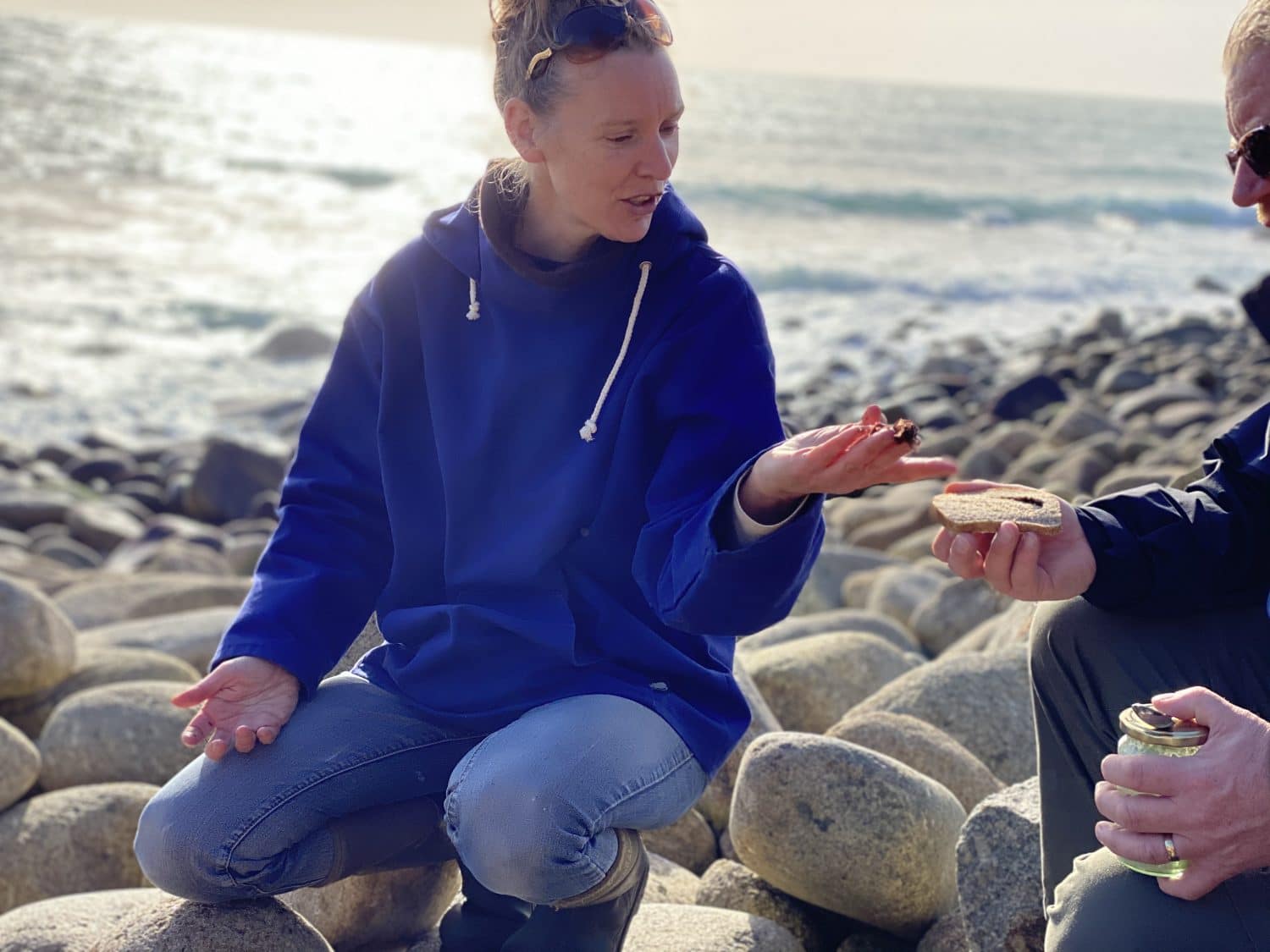
In his book Landmarks, McFarlane reflects on the fetishisation of the quainter plant names, the human tendency to impose the “tyranny of the nominal – a taxonomic need to point and name, with the intent of citing and owning.” Far from being appreciative of the floral kingdom in its entirety, humans are more likely to be worried about the threatened status of a plant species if they are aware of its folkloric history created by people centuries ago, are hooked by its name and associated superstitions, enticed by its cameo appearances in pop culture, dependent upon it for food or material uses. How a plant is of practical use to us shapes whether we value, or fight to preserve its existence. But surely this taxonomic need, if unavoidable, is actually significant in ecological thinking, that humans having invented stories and evocative names for plants isn’t based upon dominion over them, but rather a proof of our historic, profound relationship with them. An introduction via the mainstream and more palatable greatest hits before getting to the obscurest of unstoried demos and B-sides. Botanically speaking, of course.
Our ability in the Western world to identify plants by name, which has dwindled since the Industrial Age and the exodus from countryside to cities, has undergone near-obsolescence in the digital age; the result being that we’ve buried such compelling word-combinations or folkloric associations. But the rise in recent years of foraging experiences offered by guides such as Rachel, our collective revived interest in off-grid living, and the pondering all that can trigger (mine included), has meant a resurgence in interest in the botanical folk stories and evocative names of Britain’s countryside landscape. Well-trodden books like Richard Mabey’s 1996 compendium Flora Britannica and The Lost Words (also by MacFarlane), as well as countless online resources and apps for flora and fauna identification (somewhat flawed, for I’m told nothing can match receiving education in person), have brought long-forgotten language back into our contemporary lexicon.
And with it have arrived different interpretations of where those names came from and why. Even the unassuming dandelion has an origin story. Both a reference to its yellowness and the plant’s function as a diuretic, ‘piss-in-the-bed’ was an alternative name for the plant, its more common appellation hailing from the French version ‘dents-de-lion’, a nod to the leaf’s jagged tooth-like edges. Common sorrel, like the one we found on our excursion, answers to many names. Rachel has a stack of them; cuckoo’s sorrow, donkey’s oats, gipsy’s baccy, bread-and-cheese, lammie surrocks, soldiers and London green sauce among others. A thriving scheme of inter-generational oral storytelling used to enrich not only our social conversation but our symbiotic relationship with flora, and the way in which we regarded our own material bodies and their embedded place within the natural world.
“Nature does rebalance us; it doesn't necessarily have to take long, but regular dips in the outdoors do help re-calibrate us human animals.”
Full of flavour
Back on our walk, Rachel shares her love affair with the language of our natural landscape and how it’s been created and shared through the ages. “I love the oral storytelling aspect and hands-on learning of foraging, the connection on every level,” she explains. “The songs I perform as part of the experience link history, folklore and my own creative roots, and lift a walk somehow out of the mundane (which we already do with those amazing flavours) to something else – I don’t know the word, but maybe know it as a feeling.”Having started foraging in her early 20s, Rachel describes herself as “…still a beginner compared to my foraging and hunting ancestors. But it is satisfying to turn to nature, to be humbled by her, held by her. Nature does rebalance us; it doesn’t necessarily have to take long, but regular dips in the outdoors do help re-calibrate us human animals.”
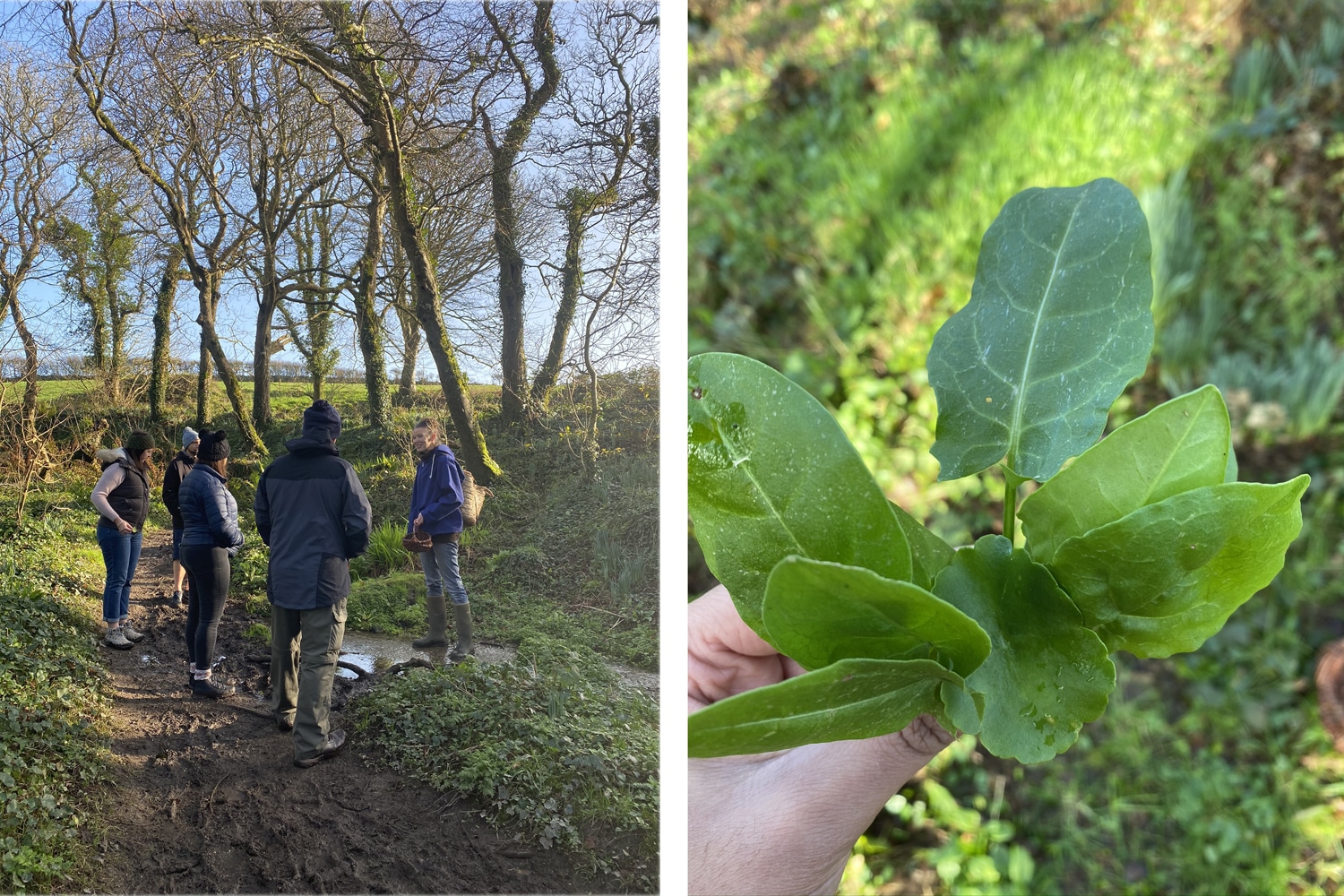
After the walk, Rachel collaborates with ‘Hole Foods Deli’ in Mousehole to host a four-course meal which showcases wild food cooking based upon her recipes. Our hand-picked sorrel, pennywort and gorse flowers dotted every diner’s plate. The dishes – Laver seaweed bread, wild garlic tarts, bream served with winkles, dulse and samphire, wild mustard mash with alexander seed braised beef, a panna cotta set using carrageen with wild berries – are completely delicious and the foraged ingredients add a gamut of vitamins and minerals to our meal. Rather than being a fashionable foodie event, the evening feels like a small experiment in wild food revival, demonstrating where we might supplement our 21st century cuisine and story worlds with these free-to-pick, fallen-by-the-wayside ingredients and flavours.
Barriers to entry
There are, however, certain obstacles to seeking out foraged food, folklore and knowledge in the 21st century. Despite the fact that foraging sustained underprivileged families throughout history – often during periods of wartime rationing or poverty (indeed, many wild foods carry the adage ‘poor-man’s’, such as samphire’s ‘poor man’s asparagus’) – the practice is flourishing as an expensive, Instagrammable pursuit. There’s a lack of ‘traditional education’ for young people (historically the beneficiaries of handed-down oral wisdom), along with a depreciated interest from us to forge a relationship with the outdoors. One fellow diner at the ‘Hole Foods Deli who runs craft and foraging workshops for students excluded from school mused sadly that the children he teaches “can’t even recognise an oak leaf”.
At the opposite end of Cornwall, Family Foraging Kitchen (FFK) is a social enterprise group offering free foraging walks for individuals and families from low-income backgrounds to combat this exact issue. Founder Vix Hill-Ryder moved from London back to Rame to set up the venture with her husband after a successful career in the charity sector. Foraging was ingrained in Vix from childhood as her grandfather was a Scout leader and amateur botanist who took Vix around Rame peninsula as a small girl to gather meal supplies. “I live in one of the poorest areas in Cornwall. While we live in stunning beauty, with a booming trade in tourism, we have one of the highest poverty rates in Europe,” Vix explains of what inspired her to set up Family Foraging Kitchen. “When my eldest was little, I helped run local baby and toddler groups. What struck me was the number of families relying on food bank schemes to feed their children. The lack of fresh seasonal produce in those boxes alarmed me. I had the knowledge to help those families add the nutrition back. Setting up the Family Foraging Kitchen enabled me to apply for funding to teach those I could, for free, how to climb out of food poverty.”
“Why on earth would you buy a salad from the supermarket, covered in single-use plastic, sprayed with chemicals, when everything you need is here for free?”
Getting a taste for it
A fortnight after the foraging excursion with Rachel, I visit Maker Heights for a ‘hedgerow and medicines’ walk with Vix’s group. Our small party has barely advanced a few steps before several plants of interest are pointed out. Vix reels off an impressive list of edible flora and recipes as we flit past the rain-sodden hedges. Her passion for botany and eagerness to spot useful flora are obvious as she scans with precision, pointing out which are medicinal (usnia, a natural penicillin), full of protein (blackberry buds and gorse flowers), or ripe to harvest (lesser celandine leaves before the yellow flowers appear).
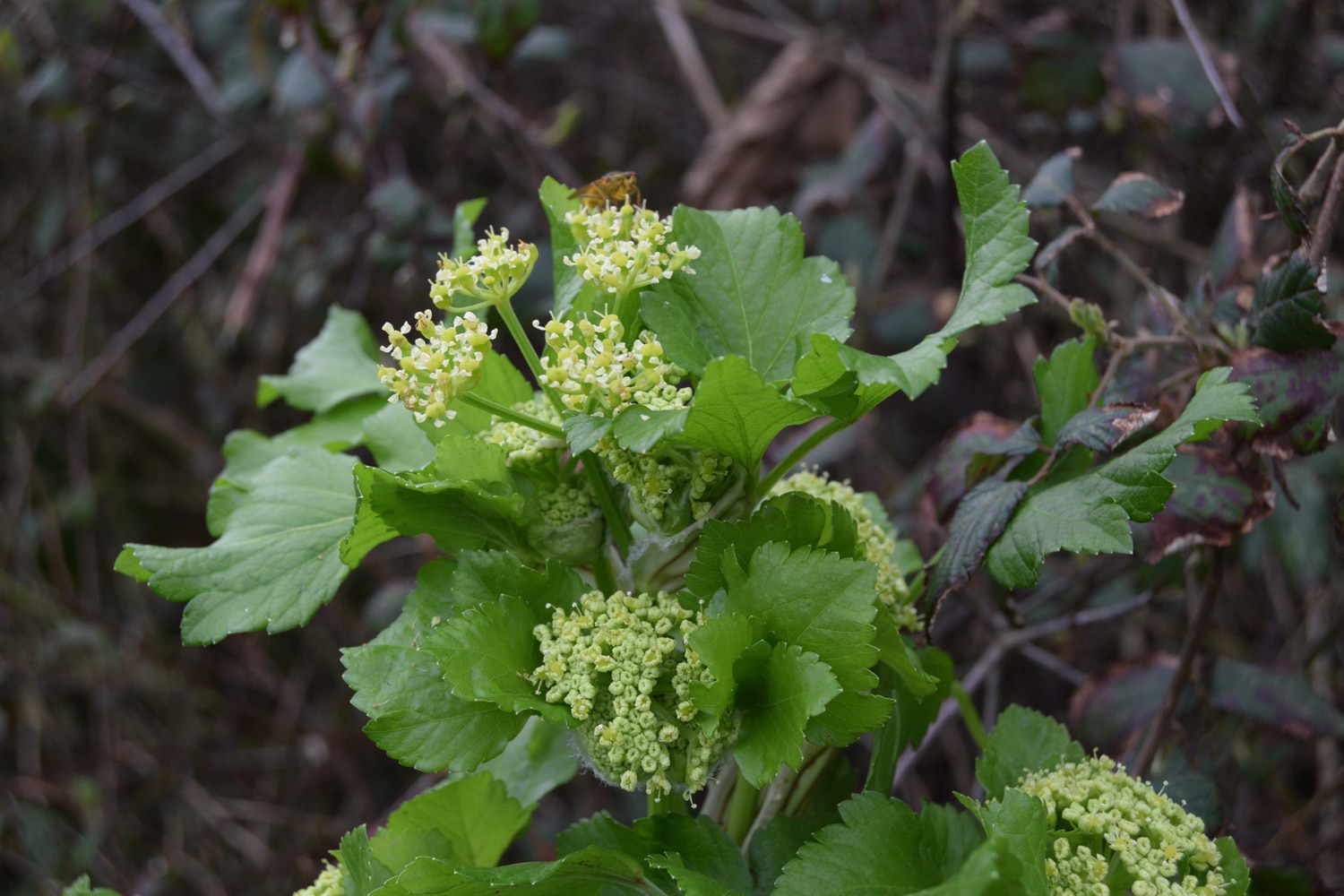
Vix gestures towards the hedge on our walk. “Why on earth would you buy a salad from the supermarket, covered in single-use plastic, sprayed with chemicals, when everything you need is here for free?” Dock leaves replace spinach, dandelion leaves replace rocket, and plenty of flowery garnishes and herbs can go on top. I see her point. Pickable food is closer than you might think. In reality, the food we commonly choose to eat is borne from convenience and habit, but also aesthetic. Vix explains that people don’t want to eat something that looks like a garden weed, no matter how much she tries to convince them of the nutritional value of dandelions, roots and all. “There is a fear and uncertainty for many people who have been brought up with a label stuck to everything they consume,” she says. “This was alien to my grandparents’ generation, who grew and foraged for most of their food.”
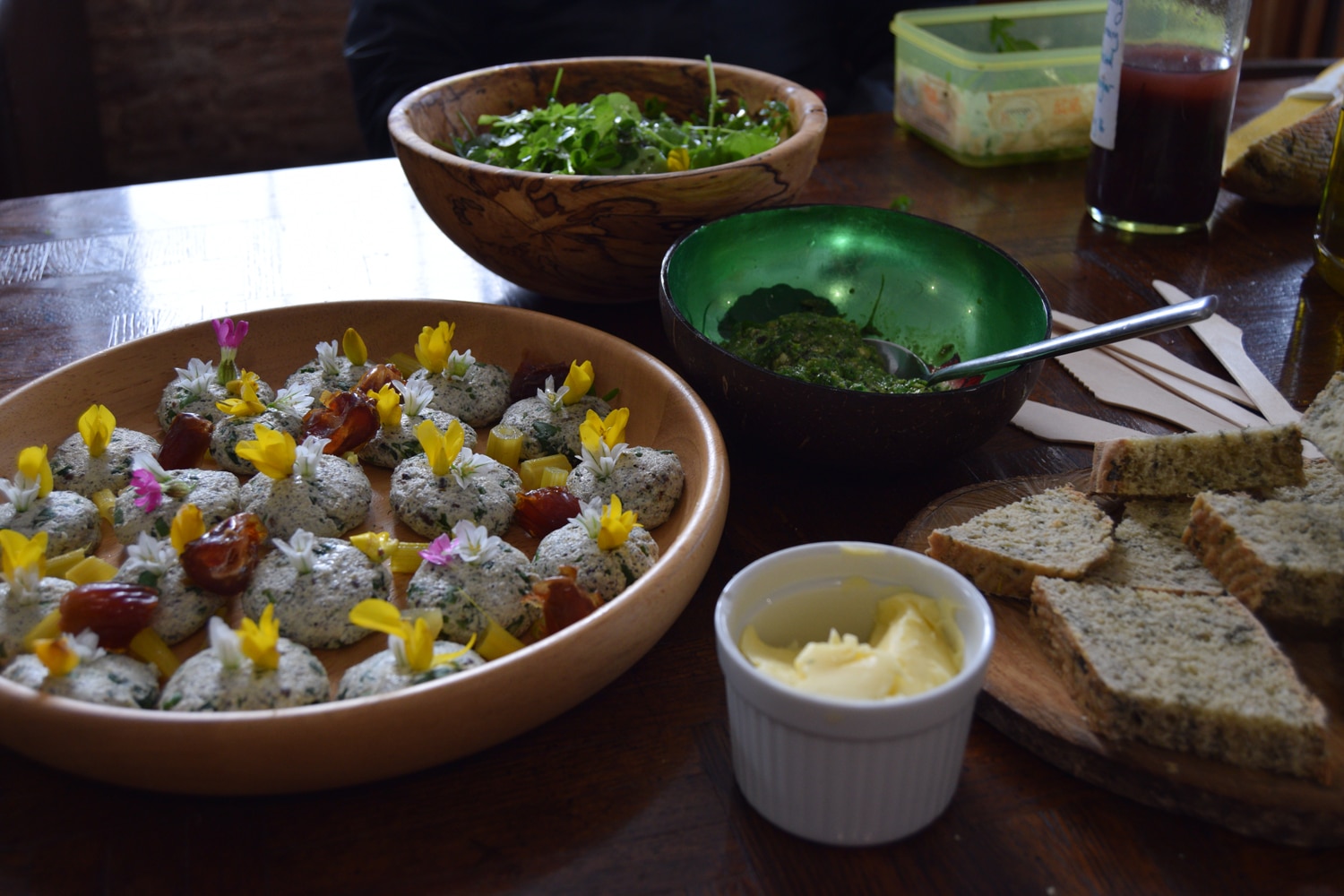
We hunker down in a building being redeveloped on the site and sit at a table, surrounded by Vix’s hand-picked goods. She pummels the nettle and wild garlic into a pesto in a large mortar and studs it into her homemade cheese rounds, which she’s seasoned with alexander seed and wild garlic. There’s wild garlic in her homemade bread too, a celebration of what’s abundant that spring season. Our salad contains everything we’ve just picked; hedge bedstraw, dandelion leaves, pennyworts, lesser celandine leaves, dock leaves, stitchwort, and once again a smattering of sunshine-yellow gorse. As with Rachel’s dinner in Mousehole, it’s completely delicious; spicy alexander seeds like whole peppercorns, mouth-puckering anise-tinged stems, the astringent headiness of the wild garlic. Vix explains that we have become so accustomed to refined sugars in our modern diets, that our taste buds struggle to accommodate the bitter, sour tastes of foods our ancestors were used to.
“There are very few local children here in Rame who haven’t been out foraging with me. It makes me smile to see them picking plants and snacking straight from the hedgerow.”
To navigate different textures using touch, needle-sharp gorse thorns, the slightest of stalk hairs, abrasive bark grooves, waxy leaves, is a rarely flexed practice, but one that foraging recovers readily. I ask Vix if she thinks that we lose out on specific haptic knowledge and perception by not being outdoors regularly, confronted by such textures and temperatures and the unknown, as opposed to handling the uninterrupted smoothness of smartphones and tablets feeding us algorithms in controlled indoor environments. “Modern technology and its advances are amazing, however it’s crucial to maintain a connection to the outdoors,” she answers. “Not only in learning about and understanding it – but for health and state of mind, to understand where our food originates – and to witness firsthand the devastating effects of climate change and our human presence on the Earth. Nature Deficit Disorder is real. Foraging is not about using only our eyes but all of our senses. It’s a vital part of human nature and we must not lose it.”
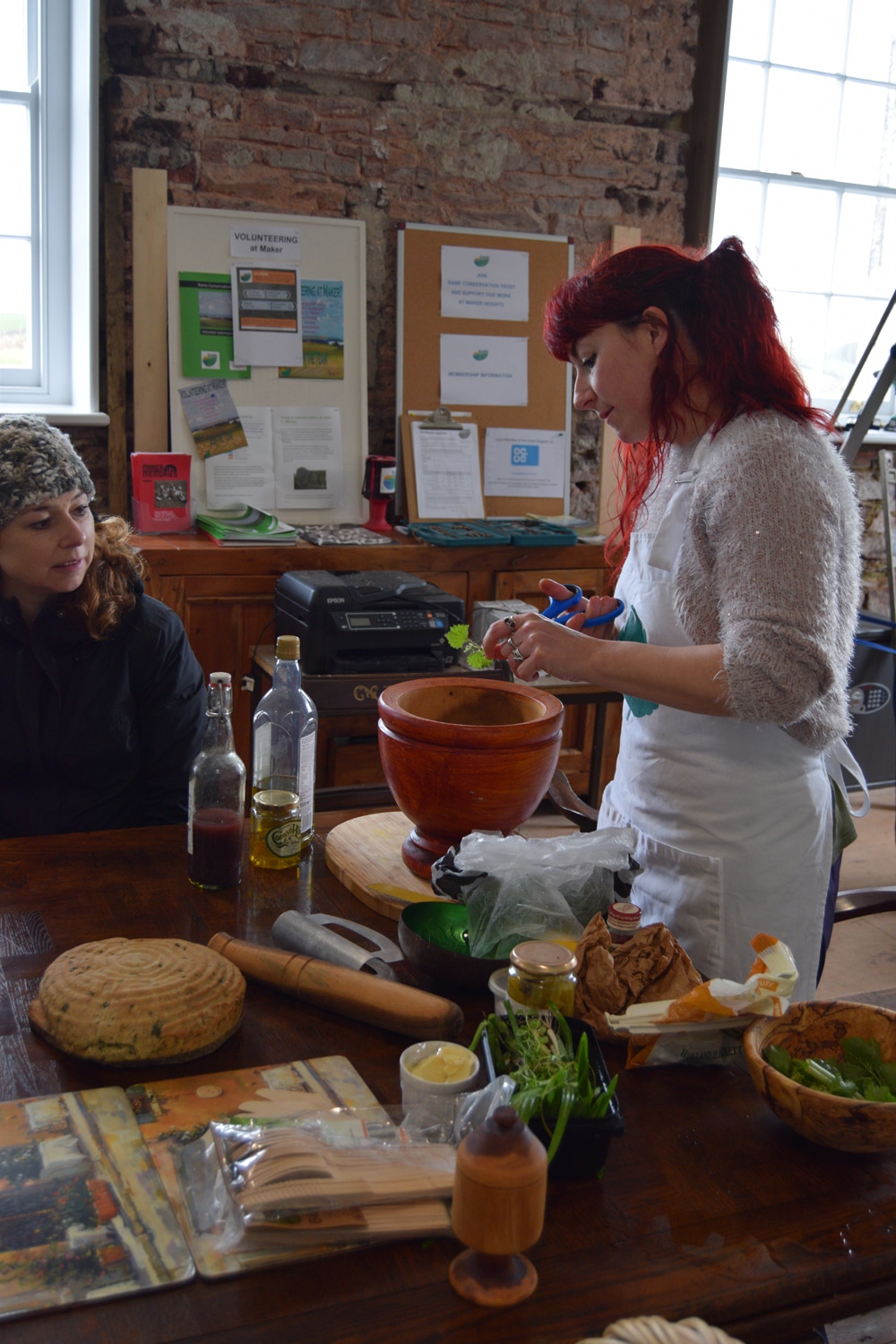
Vix is on a firm mission, encapsulated by the motto of her charity, ‘Free Food Forever’. “Having my own children and running family workshops over the years has given me the opportunity to pass on the knowledge I have of plant properties,” Vix concludes. “Children absorb information like sponges – there are very few local children here in Rame who haven’t been out foraging with me. It makes me smile to see them picking plants and snacking straight from the hedgerow. I’m proud of my heritage, home and community, and I love seeing the eyes of people open in a new way to their locality through the learning of their botanical landscape. The ability to feed and nourish ourselves sustainably, seasonally, for free, is the last true freedom we have left as human beings. It’s an important skill to gift our children with.”
After we’d said our goodbyes, I re-did our two-hour walk, testing my memory, picking more yarrow, alexanders and jelly-ear mushrooms to add to my amply full Tupperware. When I got home and over the next few days, I made ramen stock with the mushrooms, wild garlic pesto, sautéed the chopped and seasoned alexander stems and heads in butter, whizzed the leaves along with pennyworts into a soup, arranged a salad and dried the yarrow and blackberry leaves for herbal teas. I continue to harvest in the lane behind our housing estate, now offering so much more to me than the autumnal sloe berries and blackberries I’d picked before. In fact, a bounty awaits. And marking the strange passing of time after a tumultuous twelve months since being out with people in close contact and sharing just-picked food, I smile as I spot a familiar face returning to life on the hedge walls – the pennywort.
Links
Rachel Lambert Wild Food Foraging
Instagram: @rachellambertwildfoodforaging
Instagram: @familyforagingkitchen